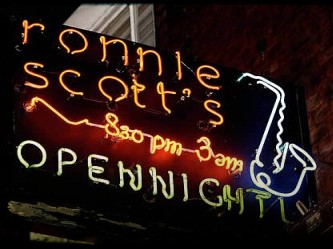Ronnie Scott’s & The Great American Export

Our ritual when flying to Europe is to catch an overnight flight, check in to our apartment or hotel before noon, then nap until the late afternoon. This way we are feeling fresh and ready to begin our trip in earnest. We then invest heavily in our first night on the town. When visiting London, the perfect first night for us is a visit to Ronnie Scott’s. Founded in 1959 by saxophonist Ronnie Scott, this world famous jazz club bustles with crowds every night of the week. Originally in a dingy basement, its more modern digs now reside in a more upscale locale in Soho. They serve food and a variety of cocktails, and the warm red glow of the main room provides a throwback charm. We make it a point to book in advance, as this is a live venue. There are a variety of seating options, all with tiered pricing, and the doors close at 9:30pm.
In true sliding doors fashion, London’s love affair with jazz might have never come to be if not for a conversation that took place in New York City’s Flatiron Building in 1912. The Flatiron Building? Well, it turns out two brothers from The Basque region (the contested territory between Spain and France) opened an establishment in the Flatiron’s vast basement and named it “Tavern Louie”. The space actually extended underground all the way across 5th Avenue. It was huge!

This unusually liberal establishment was all the rage among New Yorkers of the era, many of the patrons filing in from the theater district after a show. Women had their very own section of the tavern reserved, thus protecting them if they were not in the mood to be disturbed by overeager men. Openly gay men were also welcomed and embraced, and many of the musicians were black, among them Louis Mitchell and his band. Once again, not the norm in turn of the century New York City.
The Louis Mitchell Band, discovered in the clubs up in Harlem, brought an unheard of sound to midtown Manhattan that amazed diners. One of those diners happened to be Irving Berlin, the renowned composer and lyricist. After a set, Berlin approached Mitchell and recommended he take his act to London. Mitchell did so and became immensely popular in the U.K. in the years leading up to World War I.
Before the first artillery shell was lobbed in The Great War, the sounds of black music had already crossed the Atlantic. In the summer of 1914, drummer Louis Mitchell, considered the first man to bring jazz to Britain, and his band opened at the Piccadilly Restaurant in London. British journalists described Mitchell as “the supreme artist of noise”.
Harlem in Montmartre: A Paris Jazz Story Between the Great Wars
By William A. Shack
After the war, he returned to Europe, but this time it was Paris where he once again introduced his unique sound to captivated audiences. To this day, the French consider jazz to be the greatest American export.
So, today’s thriving jazz scene in NYC, London, and Paris all ties back to turn of the century, The Louis Mitchell Band, and the since-abandoned basement of The Flatiron Building. Who woulda thunk?

And for your listening pleasure, I will leave you with Nora Jones, live at Ronnie Scott’s, performing “And Then There Was You”. Enjoy.



